Journal
Day 1: Transit
For reasons known only to the fine folks at USAir, our tickets purchased with frequent flyer miles involve flying via Germany and Istanbul on Lufthansa and Turkish Airways. I adore Lufthansa, of course, but I've never had any experience of Turkish Air. As it turns out, this choice provides us a wonderful gift. Istanbul is gorgeous from the air! We flew over the entire Bosporus and were able to see the city below. Stunning. It's sunny and clear, and the sun glinted over the city as if we were a film crew.
We have a long layover in the rather impressive Ataturk airport. The airport has very high-end duty free and lots of elegant looking restaurants. The TK lounge is ridiculously ornate, with chandeliers and mirrors and marble. It's rather faded glory, but it's huge and scrupulously clean. I took a very elegant shower with the most ingenious paper towels and slippers provided. I would take pictures of the crazy bathing palace, but that seems really rude. Just picture marble and mirrors and gilt as if you're in a Parisian palais, then throw in some arabesque decoration, some white filmy draperies, and a lovely metal trellis.
While we wait, we are watching Al Jazeera international cover of Syria and Jordan. The demonstrations in southern Syria are growing, but it seems like the rest of the area is ok. Given the recent unrest in Tunisia, Egypt, and now Libya, it's definitely something we'll keep an eye on. There is one cancelled flight on the departures board, which of course caught my eye. Libyan air to Tripoli. Yeah...that one makes sense.
On arrival, we are whisked to West Amman, where all geography is based on eight roundabouts that lead away from the city center. We are staying near Circle 5, a quick 15 minute drive from downtown. Tomorrow we intend to head into downtown, formerly the Roman city of Philadelphia. No offense, but this is a damn long flight just to go to Philly. Though it has taken me this long in the past, I guess, and then I didn't get the cool layovers.
Day 2: Amman
Amman is built on many very steep hills, a bit like SF but more so. There are staircases everywhere. All the buildings are clad in local limestone, so it is all these shades of beige. In the bright sun it almost shines. We took a cab down to the Roman theatre, then wandered around downtown. This area has lots of 1920s villas, a big souk, and a nice old residential district. There is building everywhere, some of it new but much more redevelopment of older neighborhoods. The new buildings seem to be mostly smallish apartment blocks 4-5 stories high with parking underneath, very sensible.
The city is also very friendly. There are absolutely no beggars or hard sell vendors. Some people say "welcome" as you pass, but no following you around. It is completely different from Egypt. We understand that the Queen has a project to school and employ the street beggars, and that this has been successful enough that they are mostly working. In any case, it's a nice experience to just wander and not feel that you have to look at everything sideways to avoid being harassed.
Given the recent unrest in North Africa, it is apparently relatively quiet at the tourist sites here despite being the beginning of the high season. So far we're getting lots of gratitude just for existing. It's like the last time we were in Egypt; an attitude of defensive gratitude. "We're perfectly safe, why did everyone get scared off?!?" combined with "Thank you for being here and please tell everyone at home how nice it is". (As it turned out, although some sites were busy it continued to be relatively quiet for the time of year, and we ran into very few English-speaking tourists during our stay. We were, however, positively mobbed with European tourists on week-long package tours.)
Day 3: Madaba, Kerak, and the King's Highway
This morning we drive down the King's Highway to Petra. Which King precisely gets to claim naming rights is a bit muddy, as seems to be the case for pretty much everything in this part of the world. It is, however, undisputed that this has been a major thoroughfare for a couple of thousand years running through the fertile Jordan river valley. All along the way there are stunning views, historic sites, and lovely little villages.
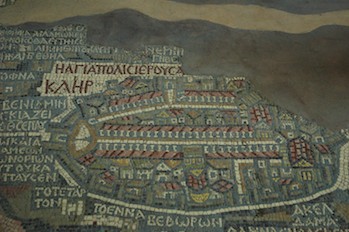
Madaba is a lovely town just south of Amman that was a center of mosaic art in the early Byzantine era. Although various political and religious waves have washed over the town, causing the mosaics to be edited, removed, covered, and now restored, the town clearly retains the skill as they still make (very expensive) stone mosaics. There's a roughly 9th century map of the route to Jerusalem on the floor of one church in town, famous for being the oldest map of the Holy Land. It's gorgeous and actually rather accurate, even if some bits are missing from damage over the years. The Lebanon coast is apparently off under some pews on the right. Somewhat terrifyingly, they still use the church and just drag some rugs over the mosaics on Sundays. Eep!
Our next historic site is Mount Nebo, where Moses saw the Holy Land and then promptly died. We did see into Palestine, although not all the way to Jerusalem, and perhaps for this reason survived the experience. Good thing it was hazy. There is an old Byzantine church on the hilltop, now closed for restoration by an Italian firm. We are able to walk around to the famous view, however, and see a lovely metal sculpture of flames licking at a staff. Also visiting today is a gigantic group of teenaged schoolgirls there who earnestly practice their English on us and are very entertained that people want their picture. There is much posing and giggling. We are interested to note that although they are almost all in hijab and long sleeves, they also all appear to have a taste for very tight, very stylish jeans. Not sure where that comes in on the modesty meter. Leaving Mt Nebo we see not one but two different Moses Springs, both of which are apparently the site where he stuck the rock and got water. Either that happened a lot, or similar to other Biblical sites there is a little local competition involved.
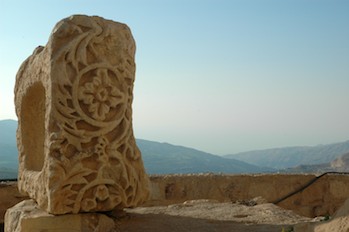
After a ton of really good mezze for lunch...sigh...we forge on to Kerak. This is one of the Crusader castles, and has a particularly nasty history of barbarism on the part of the French "king" who ruled here in the 12th century. We were there with a large French tour, who were only slightly more civilized despite the intervening 900 years. The construction is rather basic, solid without being terribly inspired, but the location is clearly a defensive dream. I will avoid repeating the various stories of people being thrown off the walls, suffice it to say there were many.
On leaving Kerak, the highway travels through a more barren region around the amazing Wadi Mujib, known as Jordan's grand canyon. It is a truly awe inspiring sight, this huge canyon leading directly west to the river. It is largely dry today, thanks to the new dam to the east. The remains of older versions of the King's Highway are clearly visible on the hillsides, and even our little ribbon of road suddenly seems rather narrow.
Finally we arrive at Petra just after sunset. Steve and I decide to head to "Petra at Night", available one or two nights a week during this mild time of year. They set up luminaria the whole length of the siq to the Khazneh, and you walk in silence under the stars through the canyon. It's absolutely magical. Or rather, it is magical in the brief breaks between chatty Italians and the large number of people who do not seem to understand the science of flash photography. Our first glance of the Khazneh looked a bit like there was a highly localized lightning storm. Here's a tip: if you need a flashlight to set up your camera, it won't take a decent photo. So stop blinding the rest of us. Once we arrive at the Khazneh, with perhaps 70% of our vision remaining, we sit on rugs amid candles and are treated to a brief concert of Bedouin music. We leave to walk back to the hotel before they spoil it by trying to sell us anything.
So... We're finally in Petra, and it's amazing! So far as we can see.
Day 4: Petra
"Petra, rose-red city half as old as time." Except it's not really rose-red. And it's old, but really only about 2200 years, which is not half as old as time even for those who disavow evolution. Then again, since the author of those words never saw the place, I suppose he did pretty well. If nothing else, he gave the vendors of souvenirs a handy catch-phrase.

We are up early in the morning to ensure we arrive at the Khazneh at about the same time as the morning light. The hotel is right at the entrance to the national park, which is billed as a huge advantage when booking. Not that I disagree, but the walk to the entrance is not really a big deal relative to the amount of hiking today! The start of the path is a wide gravel walk that slopes gently downhill. To the left is a separate wide gravel walk for the horses that one can ride down. What they don't make clear is that the horses only go about 1 km, then you have to get off. So it's more like a pony ride than actually helpful from a transit point of view. Here the valley is open and the are just a few carved caves and stones along the way to whet your appetite.
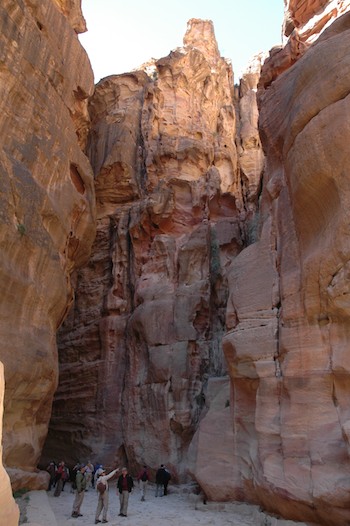
After about 1 k, the path becomes narrower and the grade steeper as you enter the siq. The way immediately becomes rougher, a mix of loose stones, Roman pavers, and modern cement. While it's lovely to walk the Roman road sections, you can't help but notice that they seem to have a serious pothole problem. The walls of the siq are about 20 feet high initially, rising to probably 100 as you walk. The path becomes shaded and cool, with the occasional quick breeze rushing down the canyon toward you. The walls are largely left natural, although the entire length of the siq there are water troughs on both sides. These are carefully built to collect rainwater and channel it to occasional reservoirs along the way. The Nabateans were masters of hydraulics, no doubt necessary to support cities of 20,000 in the desert. The channels can be mistaken for natural erosion in some places, they are so carefully placed. The siq winds slowly downward, the walls sometimes only a few feet apart. From time to time there are little niches or carvings, worn away by water and wind to lumpy shapes. The light on the walls is fabulous - angled to reveal beautiful colors in the sandstone, highlighting the occasional tough little tree clinging to the sides. It also provides lovely amplification for the constant loud complaining of the polyglot crowd of people trooping down with us. The phrase "are we there yet?" echoes from the walls in multiple languages. Although the horses from the entrance had to turn around at the entrance of the siq, you can hire a donkey cart to take you through the siq to the Khazneh. Given the width of the path, these can be a bit dangerous as they whip past, terrified tourists hanging on for dear life as their crazed driver parts the sea of walkers with a cry of "yalla yalla!". Those things should have horns, or possibly a tourist-catcher grill on the front.
Over the last few days, we seem to be traveling in step with a group of about 30 French tourists. We keep bumping into them and nodding politely. Well, we nod politely and they wonder who let Americans clutter up such a nice country. One of the members of this group is in a wheelchair, pushed everywhere by her daughter. We noticed them previously and were impressed that the daughter was managing to drag the chair up hills and into the castle at Kerak. This morning we come upon them halfway down the siq, the daughter slowly easing the chair backward over the rough ground. It looked like incredibly hard work; just getting to the Khanzeh takes 20 minutes even if you walk quickly, and anyone risks turning an ankle on the many sections that are mixed pavers, gravel, cement, and rubble. It seems impossible to drag the wheelchair, complete with elderly Belgian occupant, down this path. Several of us offer to help, but short of carrying the thing on a litter, it doesn't seem possible. After a few minutes the driver waves us off, then doggedly drags the chair over the next section of gravel, her mother in the chair complaining the whole way about the ride quality.
Finally, we come upon a knot of camera-wielding tourists crammed into a tiny space on the left side of the siq. We don't hear a donkey cart, so it's possible this is a photo spot. Sure enough, once our turn in the melee comes around, we see our first sight of the Khazneh. There's something wonderfully evocative about seeing a glimpse of this huge, rather ornate structure through a gap in the rough canyon walls. It's the standard picture of Petra for a reason, and all of us line up to try our hand at capturing the feeling of stumbling into order from chaos. When this was a caravan stop, this must have seemed like a magical transition from days in the desert to suddenly finding this cool, watery, orderly place. Much like we will feel this evening on walking back to the lobby of our very Swiss hotel. Not sure that the Nabateans provided ice cream in waffle cones, though.
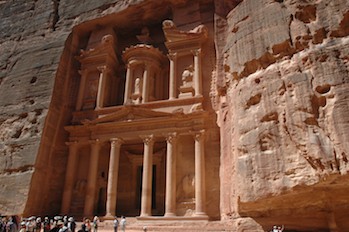
The Khazneh was featured in Indiana Jones as the site of the Holy Grail. Unfortunately reality is not so exciting, as the interior is just a big, dark room with some benches on the side. The building is huge, scaled far larger than for normal use, clearly intended to impress. The speculation is that these huge carved structures were tombs and/or temples. I guess "Four Seasons Petra" is right out. The facade is only in light about 2 hours a day due to the narrow canyon, so it's a mild photographic mob scene as everyone tries to get the same shot of their traveling companion standing in front of this (quite large) building. Due to the narrow width of the canyon, there's a very limited area that allows a full view of the building, and naturally the camel drivers choose part of this space to hawk transport through the site. (The donkey carts can only go to the Khazneh, not beyond, as that is apparently camel territory. I wonder if there are three different tribes that lotteried off the rights to sell transport to weary tourists?)
From the Khazneh, you turn right and go down a small hill to find the main drag of Petra. This is an L-shaped canyon, now quite wide, lined with tomb/temples on both sides. The Nabatean structures are carved from the canyon walls, starting from the top and working down. They are almost like reliefs, as the edges blend into the stone seemlessly without separation. The interiors are essentially squared-off caves. The sandstone is variegated with many different colors due to mineral oxidation and deposits from water, and it is soft enough to have interestingly smooth sections. The temples sometimes seem to be emerging from the stone walls, or melting back into them, and it's all too easy for your eye to see eroded columns in every vaguely linear corner.
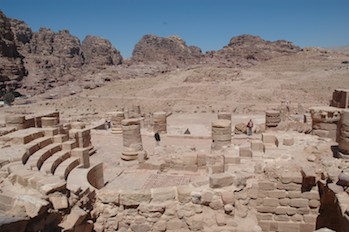
As we turn left, following the main canyon, we find the Roman section of town. After the Nabateans were conquered, the Romans used this as a local capitol. In typical Roman spirit, they built a nice straight colonnaded walk with a big temple on one side, and put in a theatre around the corner. They clearly had no patience for this semi-organic construction style that followed the existing canyon walls. The Byzantine Christians that followed them didn't even try, they just put their churches on the hills. At one point you can see all three eras of building from one spot, which is a bit like being in a furniture showroom and trying to decide between Colonial and Scandanavian.
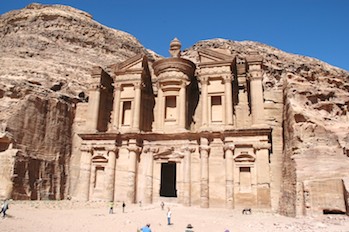
There is a dense collection of buildings in this open space, which has attracted the modern marks of souvenir stands, tea rooms, and young boys selling donkey rides. These donkeys are to help you get up to the Monastery, a particularly lovely and gigantic temple up 900 "steps" from the main section of town. We politely decline the donkeys and begin the climb. As is often the case, the steps in question are a mix of ancient, old, and new, of varying heights and wear. In some places it's pretty much just a pile of rocks. This provides an interesting insight into national styles of hiking. If an Aussie says "it's just a bit of a scramble", fetch your crampons. The French seem to climb much as they drive around the Etoile, with blithe disregard of physics. I fear that they wouldn't much care if they pitch an American off into a cravasse, so I try to stay to the inside as they elbow past. As is often the case on such climbs, every so often there is a little souvenir stand staffed by locals who run up and down the hill in flip-flops while carrying gigantic bags of merchandise. Their rallying cry is generally "all 1 dinar!", although as we get higher they sometimes switch to "no charge for looking" to appeal to panting climbers.
At the top of the 900ish steps, we find an open plateau with a truly gigantic temple. This is the largest of all the buildings in Petra, and it's almost comically huge. It sits up on top of a ridge, rather than at the base of a canyon, and it's more visible than some of the others. There are several hills nearby that you can climb to get an even better view. In fact, three of them sort billboards claiming they have the "best view in Petra", but since there's no charge to climb them, it's not clear who felt the need to advertise. We pick the one with the least "scramble" of a trail and are rewarded with a view stretching from the Dead Sea to the high desert. Jordan is not a terribly large country, and sometimes it strikes you how close together all these Biblical and historical sites really are.
It is interesting to note that the names we use for these temples, the monastery, the treasury, etc, are what these buildings were dubbed by the Bedouin who lived among them for the last hundreds of years. They have no relation to their actual use. The legends developed around the buildings are wonderful, with djinn and lost treasure, and probably a Grail or two. The tribes lived in caves among the temples until the mid 80s when they were encouraged to relocate to a village built for them on a nearby hill. In compensation, they are the only ones licensed to work inside the site, providing hooved transport and overpriced soda to the masses.
As we continue to make our way up and down the rocky hills, somehow always more up than down, we notice that there are really no signs or trails or barriers. A few paths have been worn to the high-traffic sites, but it's easy to go astray and find yourself at a drop off or dead end. There are no fences around the national park, and the ruins extend for many kilometers. I'm rather glad I haven't yet seen 127 Hours.
The afternoon light highlights different parts of the city, picking out different walls of the canyons and different temples. It seems you only really see parts of the city at any given time, with new ones soon to emerge. The rocks are beige, black, ochre, brown, and finally even rose red as the sun goes down. As the light fades, we say farewell to the Khazneh, looking back to watch it go back into hiding, safe at the end of the siq. It's a long slow trudge uphill, and we are constantly passed by first camels then donkey carts then horses. The price for a ride back to the gate drops with the remaining tourist population, but we stick it out and finally arrive at the top of the hill. The effect of the long climb from the siq is almost of emerging from the past and back to the present. As lovely as the site may be, I'm very grateful for my soda and Saudi knock-off KitKat bar, the modern oasis stop.
Day 5: Wadi Rum

We start our day with a visit to "little Petra", a small outpost a couple of canyons over, much like airport hotels out by the highway. One very unique find here is a remnant of a painted ceiling on one of the tomb/temple/conference rooms. Most of these hollowed-out spaces were used as bedouin dwellings for years, so the ceilings are black with soot. This one has a niche that was relatively unscathed and recently revealed these very delicate paintings of grape leaves and flute-playing nymphs that wouldn't be out of place in a Greek villa. Much of the decoration in Petra seems to hark to other civilizations. A little Greek, a little Roman, a little Babylonian, all slightly adapted. It's kind of like one of those Tibetan stores in Cambridge that sell everything from prayer wheels to oriental rugs to totem poles. Apparently they picked up a bit from everyone who traveled through and created their own eclectic style.
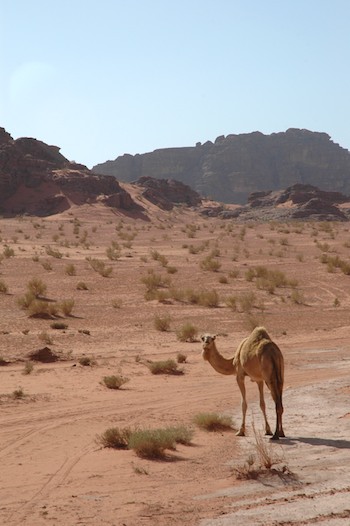
Wadi Rum is a stunning bit of desert about an hour from Petra, famed for being the home of TE Lawrence and Prince Feisal when they were fomenting the Arab revolt and attacking trains. David Lean actually filmed large chunks of the movie here on site, so you can see some of the landscapes complete with suitably atmospheric camels. (Sorry, I should call them dromedaries. Apparently camel is a derogatory or imprecise term here and we are constantly corrected.). After a short over-produced documentary film extolling the virtues of sun, sand, and dramatic pauses, we head out on modified pickups for our tour. These are mostly ancient Toyota Hilux flatbeds with rudimentary benches welded into the back. You climb over the end to get in, and if you're lucky there're a little padding on the seat. I know that Top Gear claims you can't kill a Hilux, but perhaps they haven't tried Rum. Our first one was running low on fuel, so we switched. That one nearly took out a member of our group when one of the seats came free, toppling him over into the (fortunately soft) sand below. This one was repaired with some rope and we continued on, using only one of the seats. Unfortunately the ride was not enhanced by allowing the small son of the driver to take the wheel. The third one seemed safer, although seemed to have lost any pretensions to suspension. The bedouin drivers calmly barrel up and down sand dunes, half-sliding down some grades, occasionally getting a young boy to jump out of the cab and lock the hubs for a tricky bit. Assuming the young boy isn't busy driving.
The view from these dubious conveyances is absolutely stunning, once you figure out how to hang on to secure truck bits long enough to look at it. Much like nearby Petra, one of the first things you note is how richly varied are the colors of the desert. The rock formations are wonderful, with beautiful erosion patterns and wind-carved niches. It looks much like photos of the Utah desert that I've seen, although I'm not sure how they actually compare in person.
Overnight we are staying in a "Bedouin tented camp". We had a bad experience with a Bedouin camping night some years ago in Sinai, so I was fully prepared to once again ditch the group and sleep in the van. This time, though, it turns out this is sort of the Epcot version of Bedouin tents. There is a rather large complex with a big central square, featuring a dance floor and some rather large speakers. There's a fire pit in one corner, a bar in another, and low tables for eating all around. Tables for the dinner buffet are set out with gigantic stacks of Saran-wrapped plates at one end. The accommodations are in what looks like long Bedouin-style black and white striped tenting with a semi-permanent roof. Similar structures are used all over Jordan as souvenir stands and coffee shops. These have partitions inside, and a red clay floor. There are metal rods guiding the partitions that also allow for power outlets and light switches to control the two hanging lightbulbs in each section. There are actual metal bed frames with thin mattress and basic linens, including some blankets "made of real mink" for which many poly esters gave their lives. Another black and white striped partition, bizarrely opened with a comically huge black zipper, reveals a red clay enclosure containing a basic shower, toilet, and sink. This appears to be a huge move up from our last such experience. After a basic dinner and a quiet hour at the fire drinking tea and attempting to remember constellations, we turn in. No flashlights, no hurricane lamps, no mosquito nets, no zipping tent flaps, no washbasins - this is great! We switch on the light (!!) and wash up at the sink (!!) after using the flush toilet (!!!). I notice that my hiking socks have turned bright red on the bottom thanks to the clay floor. Well that's unfortunate. The sheets are very rough, so we decide to sleep in our clothes, which also will probably allow us to avoid the "mink" blankets that look pretty dusty. We turn off the light and settle in.
Keep in mind we are in the middle of a dessert, many kilometers from the ocean or any other water source. The biggest danger should be dust and maybe the feral housecats fighting over scraps near the bar. Which is why we didn't quite believe it when the first mosquito flew by. Fortunately I was quickly convinced and insisted on getting out my repellent. We then tightly shrouded ourselves in the sheets, and I covered my head with a spare jacket. The few square inches of exposed flesh on my face were lathered in repellent. The mosquitos were vicious, attempting to find passage over my ears and at my feet, checking for chinks in the armor every few minutes. In an attempt to protect me, Steve swatted dozens down and tried to create a human shield over my head at the worst bits. I started to feel like we were in a bunker under heavy fire, perhaps guarding our homeland from small itchy aliens. The night grew colder, but the mutant bugs showed no sign of letting up. Wave after wave of determined little fighters came over the edge, flying in formation, dodging and weaving to avoid Steve's ever less accurate defensive measures. There was little sleep. Eventually the sky began to lighten and we were able to escape, only to learn that we were comparatively lucky. We were the only ones with accessible repellent! As we stumbled, tired and dusty, to breakfast, our compatriots arrived with red lumps all over their faces and tales of hiding under hats and dampening towels for better accuracy in fighting back. It seems that plumbing in the desert is a Pyrrhic victory, as it makes the dessert habitable for watery creatures while simultaneously gathering tasty treats mere feet away.
We are none of us particularly upbeat regarding the planned morning of further desert exploration. I avoid the optional camel (er, dromedary) ride, as I have no intention of allowing one of those creatures power over me ever again. Steve joined me in the back of yet another Hilux as we bounced up and over dunes, stopping to enjoy truly fabulous sights. At midday we returned to camp to do a lightening raid on the pseudo-tents to retrieve our bags, and got on the mercifully air-conditioned bus to head to Aqaba.
A few years ago I announced at I was done with the Amazon. I've been several times, it's very interesting, but I do not need to spend another hour in the Iquitos airport counting mosquito bites all over my body. When we were in Palau, we learned that my ear canals are not conducive to prolonged snorkeling. Now I think we can firmly add Bedouin camping to the list of things I've done enough. There are many wonderful experiences in this wide world, it's time for someone else to take a turn. I'll just be over here where there's a bit less goat hair.
Also, it just seems cruel to name a place after an unavailable anesthetic.
Day 6: Aqaba and the Red Sea
After a quick lunch under the gaze of ever more predatory housecats, we depart Rum for the nearby port city of Aqaba. The city rests at the very point of the Red Sea, and is Jordan's only ocean coastline. The desert highway rumbles with trucks heading to not only Jordan but also on to Iraq and Saudi Arabia. Aqaba was one target of the Arab revolt, and it is featured in Lawrence of Arabia as the site of an early victory. At the time, this was a small town, but it has grown rapidly in the last 20 years. Much of the business of the city is from the commercial port, the rest from beach resorts up and down the short coastline.
The geography of this point of the Red Sea is very interesting. Historically, there was a small town here, Ayla, on the site of modern Aqaba. Settlement here dates back to the Nabateans at the least, although much of their business ran down to Saudi Arabia via desert rather than by water. Today four different countries have coastline within sight of each other. The Egyptian coastline that runs up the East side of Sinai from Sharm ends just before the point at the very small and recent addition of Taba. This town is noted on the horizon by the single, large tower right at the border. Next comes Israel and the town of Eilat, the largest community in this short stretch. The short Israeli coastline (perhaps 10 km) is a vestige of the post-67 settlement that gave Sinai back to Egypt with some benefits for Israel. Next comes Jordan, right at the tip of the bay, and what is now called Aqaba rather than Ayla. The Jordanian coastline was originally only 6 or 7 km, but a deal with Saudi Arabia in 1968 added about 10 km here in exchange for a chunk of desert inland. The city of Aqaba is smallish, then we drive down the coast to see first the commercial port, then the backroad to Saudi Arabia's inland cities, then the little resort cluster of Tala Bay where we are staying. About 3 km down the road is the Saudi border, entirely resort-free. From the hotel pool, you can look out and see the twinkling lights of Eilat, the one big tower that marks Taba, and the smaller collection of lights at Aqaba. The significance of this tiny stretch of coastline is clear, and it is easy to imagine exactly how tense this area must be at some times. We are fortunate that although there is trouble in this part of the world right now, it's due to internal politics. Less than 10 years ago there were rocket attacks on Aqaba hotels.
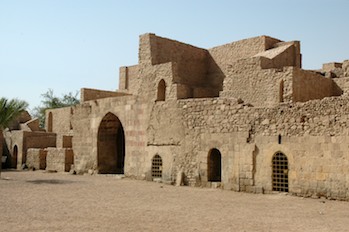
There isn't much to see of the old Ayla, which seems to be the theme along the Red Sea coast judging from our visit to Sharm a few years ago. These cities are all about the modern resort, little cafes right on the beach, and providing a place to let your hair down a bit. The original fort is still here, right on the water just behind a gigantic flagpole, but there isn't that much to it. It seems to be almost in the way of a small beach-side playground. The flagpole is billed as the tallest free-standing one in the world, which makes it just a bit pointed given you can no doubt see it from all three other countries. Hi, Israel! How you doing over there?
The letting your hair down bit is rather ironic, as this is actually the most socially conservative bit of the country. It is close to Saudi Arabia, and the tribes who live here in the past circulated into Saudi territory for much of the year. But this area is very popular with Jordanians who drive down in the cooler winter months to swim in the warm water and enjoy a beach holiday. It is much warmer here than in the Jordan valley hills, a benefit in winter. I understand it's scorching in summer, however, and the little city rolls up the streets for a few months. The public beaches today are mostly populated by shirtless young men splashing in the water and playing games on the beach. Women in full hijab watch from the shade, or wade out into the water to their knees while fully clothed. Modest dress here can either mean a floor-length abbaya zipped over other clothes or a loose, long-sleeved, high-necked blouse over jeans or similar dark pants. Among young women the jeans are often very stylish and notably tight, worn with cute little heels and low-necked tops supplemented with high-necked undershirts or a white scarf tucked in the top. Hijab come in a rainbow of colors, generally with patterns and fringe, often complementing the abbaya or top beneath. The colors are relatively bright and varied, the accessories many and jangly, but they still look awkward standing in the surf fully dressed.
Go to the resorts, however, and a different picture emerges. As these are for foreign visitors, people wander around the lobby in t-shirts and bathing suits just as they would in the Caribbean. Most of the guests are European, so it's tiny Speedos and gold chains all around. Suddenly I value the forgiving abbaya just a bit more. There are also a few local guests, mostly rich urbanites escaping for a short break, no doubt enjoying the opportunity to openly wear a bikini and uncovered hair without attracting stares. Some of these are local families with modestly dressed women shepherding children to and from the pool. This resort seems to cater to families, with big rooms and a separate children's pool, as well as a children's section to the nightly buffet dinner. I try to watch the hijab-wearing women when they encounter their bikini-clad countrywomen, but I can't discern any reaction. They seem more interested in worrying about the ever-reddening Germans and keeping their flock of kids from eating nothing but chocolate. I wonder what they think, and if they would like similar freedom? Or perhaps they feel sorry for these women for having lost something valuable by becoming Westernized? Maybe it's a sort of local Rumspringa? All the local families, regardless of dress, are incredibly welcoming and lovely to the tourists in multiple languages. It really is an incredibly polite country.
Unfortunately, our enjoyment of this gorgeous place is hampered by the receipt of an email canceling the Syria half of our trip. This is Thursday afternoon, and we were due to cross into Syria on Sunday afternoon. Now we are all at sea, with no idea what will happen on Sunday, or how to get home. The next few hours are a blur of phone calls and emails, trying to figure out how to change our tickets from Damascus, or maybe just buy tickets from Amman to Istanbul to catch our connection, or perhaps just book a new flight, or or or. Much help from the States provides some options, but none complete. We go to dinner facing the possibility of having 8 days to get from Amman to Istanbul on as little money as possible to make our connection home. Sounds like a reality show, not our relaxing vacation. This is why we pay a travel company to arrange everything, particularly in countries where you can't just make all your bookings online! At least dinner is lovely, sitting out by the pool and watching the lights of the various competing resort towns reflected in the water. At about midnight we just give up on our original flights altogether and find cheap one-way tickets home on Orbitz. Our WiFi hour holds out just long enough to get a purchase confirmation, and at least now we know we can get home without performing any Roadblocks or Detours. Can't believe I'm going to say this, but thank you Alitalia! And thank you Aqaba for a mosquito-free night, a beautiful view, and many cups of much-needed tea.
Day 7: From Red Sea to Dead Sea
Over breakfast this morning we discover that we are the only ones of our little group that have a way to get home. Everyone else has a plan, but they are proving impossible to execute as today is Friday and all local airlines are closed. Unfortunately the US offices are proving minimally helpful, so there's little to be done until at least tomorrow and possibly Sunday. Given we were originally supposed to be in Syria Sunday afternoon, that seems a little tight! We've been given an extra night in Amman, so we can leave Monday, but it's a nervy group departing today. The news from Syria is so far unremarkable, although local opinion is that President Assad's speech last night was unhelpful in quelling demonstrations. This afternoon will show if they will continue, and if so, where. It's a moot point for us now, but we all hope that no one is hurt.
From Aqaba we follow the border north toward the Dead Sea. The land is hilly and dry, baked beige in the sun. For obvious reasons, there is little in the way of building along this road, just the occasional gas station and many watchtowers. Apparently there used to be many checkpoints along this road, but these have been removed to allow freer traffic. It does feel just a bit awkward, though, with a fence line in the midst of the desert.

After a while we come to the shore of the Dead Sea. At one time, this connected to the Red Sea, but the combination of the low sea basin and the surrounding hills cut it off. We have descended hundreds of feet since leaving this morning, and at one point I actually hear my ears pop a little. The Dead Sea is famously salty, with high mineral content due to a very high evaporation rate. The inflow into the sea from the Jordan River has diminished dramatically in the last 30 years, and in fact we are told that the level of the Sea has dropped 9 meters in the last two decades. The shoreline is steep and rocky, with white salt deposits extending a foot or so onto shore. The water is so salt and mineral-laden that it cannot sustain life other than some extremophile bacteria. The landscape is peculiarly deadened, with little bird life and no obvious small animals. It's not particularly green, either, as there is plant life only around the small feeder springs and streams. The edge of the water is an odd light greenish color, partially due to reflection off the salt-covered stone. At a few flat places there are salt pans, used now as in millennia past for salt collection. Jordan historically has provided salt to much of the world, from the Dead Sea as well as from the desert to the east from literal salt mines. There is even a town called Salt west of Amman, which begs the question whether the town was named for the mineral or vice versa. Maybe it was early branding, much like Kleenex or Xerox?
As we drive northward, we begin to see groups of cars pulled off the road. On the weekend Jordanians drive down and find a place with both access to the water and a nearby fresh spring. We see large groups of people floating in the water, and others climbing inland to banks of trees to wash off. Other groups picnic near their cars and enjoy the warm day. Despite the relatively dry landscape (other than the sea), it's warm and humid here. The low sea with high surrounding hills forms a bowl that keeps in all the evaporated water, creating a constant haze that softens the sun's rays while retaining the humidity. We are told that you cannot get a sunburn at the Dead Sea, as the haze blocks the UV rays. I am of course the acid test of such a bold assertion, and resolve not to test the theory if I can help it. Of course, even waterproof sunscreen might struggle against the power of what is essentially brine. Though here's a thought - if the haze blocks UV, can vampires live here? Could there be a fifth Twilight novel set in the Holy Land, with some sort of espionage backstory?
Jordan and Israel both have resort communities on the Dead Sea, essentially opposite each other toward the northern end. This may be due to proximity to the population centers of Jerusalem and Amman, or may be due to easier access points to the water, it's not entirely clear. But in some sense it's Aqaba all over, with Israeli resorts in easy view. There are a string of hotels, a convention center, shopping areas, with the population density rapidly rising as we get to the north end of the sea.

Not far past the edge of the lake we stop at the Baptism Site, Bethany on the Jordan. This is reputed to be the site where John the Baptist baptized Jesus. The historical evidence for this location is comparatively strong, with a series of church foundations dating back to the 400s, most including large baptismal pools. There are multiple traveler's accounts that document the structure of these churches dating back to Greek historians in the mid-500s. A new visitor center complete with guided audio tour and numbered walkway provides access to all the various churches, modern and ruined. We learn how to use our fancy audio guides and set out. It's a hot day, and the sun bakes down. Being dunked in a river starts to sound like a really good idea, particularly since the overly dramatic voice of the guide keeps going on and on about it. It is clear that the audio guide script was written by someone assuming that all visitors are pilgrims, which may be reasonable given that this site is considered one of the most holy by some branches of Christianity. It doesn't particularly help those of us who are less conversant with the Biblical references constantly cited, or those of us who would prefer a more historical rather than spiritual perspective. At one point I give up on trying to get the guide to give me the next section in English rather than Russian and just read the signs. I feel vaguely guilty for not being more impressed.
Finally we wend our way down to the river itself, and have the opportunity to dip our hands in the water. My mental image of the river Jordan is of a broad and slow-flowing river, a significant geographic border for thousands of years. I'm not quite prepared for a muddy, sluggish stream not 6 feet wide, lined with brushy tamarinds and guarded by a bored-looking Army officer. Directly across the water, so close you can almost hop across to it, is the competing Israeli baptism site. This is a huge, newly-built, shiny center with metal railings and handicapped ramps and a big complex flying the Israeli flag. It definitely puts the cute little wooden dock we're standing on in the shade. The Jordanian explanation is that about 10 years ago the Israelis suddenly started claiming that the baptism site was really on their side of the river, and built this huge center and a bunch of big churches. There seems to be some tit-for-tat church building going on, as there are many new churches dotting the hills on the Jordanian side as well, including a little Greek Orthodox one right at the riverside. There are certainly a lot of reasonable-looking Byzantine and later foundations on the Jordanian side, but then I have no idea what the Israeli center can provide as evidence. I find it both funny and sad that a Moslem country and a Jewish one are one-upping each other over a Christian site. At least it's all about who's got the bigger visitor center and not about shooting each other.
Similar to the Dead Sea, the level of the Jordan river has dropped precipitously in the last 20 years. Some of this is due to damming upstream, some to population increases on both banks, and some to what is probably dramatic mismanagement. Jordan means "meander" in the original Semitic languages of the region, and the river used to be the wide, slow-flowing, significant feature that literature would suggest. It is rather sad to see it reduced to a largeish drainage ditch. Given the heavy scrub on either side, it also doesn't really seem to be much of a deterrent to military force. Altogether a rather anti-climactic visit.
We return to the resort area to find our hotel, a huge sprawling complex built to resemble a local village. The rooms are in small, inter-connected mud-brick buildings, each named for a local town or geographic feature. These run from A to Q, so presumably they have room for 9 more somewhere. The buildings run down the hill toward the water, interspersed with a market square (restaurants and shops, with live music and belly dancing at night), multiple pools, and a large spa complex. This is supposed to be one of the top 5 spas in the Middle East, with a price list to match. The whole things feels very Disney, down to the golf carts that drive us to our building. The rooms are lovely, though, with old fixtures and beautiful wooden windows. We unpack and change for the walk down to the beach.
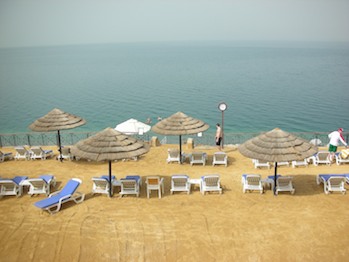
The first thing we notice is that this is a very loooooong, very downhill walk. At one point there is a small funicular that can shuttle you to the beachfront bar, although this is out of service during our stay. Instead we descend many flights of stairs to reach a very trendy bar with a small adults-only pool and what is clearly trucked-in sand. There is no sand at the shore of the Dead Sea, just large pointy salted rocks. The place is mobbed with day-trippers from Amman in for a dip, a day at the spa, or just a nice day sitting by the pool. They charge some huge rate for day use of the facilities, but even so almost everyone there seems to be local judging by the color-coded towel system. There's nowhere to put our things, so we press on to the lower beach. More trucked-in sand, another bar, a bunch of claimed chaises, but we still can't actually see the shore. We walk to the edge and look down. There are 3 staircases that lead to a small walkway built on the rocky shore. There are a few fresh-water showers and a couple of chairs for lifeguards. From the walkway you can descend one of 3 ramps to the water. There is a small sandy area with a pot of Dead Sea mud. That's it. HUGE resort, teeny tiny water access. You would think it would be mobbed, with just 3 little ramps and no space to wait. But it's not. One reason is that there is a time limit to bathing in the sea of 20 minutes. It seems that most locals go and bob around for a few minutes, then concentrate most of their time on the swimming pools and fake beach above.
The first step to entering the water is getting up a bit of courage to go down the ramp and balance on the very slippery rocks. The next step is to convince yourself to let go of the railing and sit in the water, as normally you would just wind up sitting on pointy rocks and feeling like a fool. Instead you tell yourself you will float and slowly let go. And you do. It's completely bizarre. Water just doesn't DO this. If you push off a bit, you find yourself bobbing along like a cork. You can just completely relax your limbs and they float. I finally get up the courage to relax my neck and my head floats. Once you get used to it, you can start doing experiments in buoyancy. What if I try to get into a sitting position? How about if I grab my ankles and make a V? You can hear astonished exclamations floating across the water. There is a current, so we found ourselves slowly bobbing north away from the ramps. It's difficult to tread water, and you can't attempt to swim. You definitely want your face well out of the salty water, and even splashing is clearly a bad idea. We gently tread water southward and keep bobbing along. You quickly realize why there's a time limit, as after about 15 or 20 minutes you can accurately identify every raw place on your skin, every bug bite, every slightly sunburned spot. Steve was advised not to shave this morning, which was apparently really good advice. Stinging a bit, we slowly tread water to the ramp and just paddle in. You can keep treading water until you only have a few inches left, which is utterly weird. We then head immediately for the fresh water showers to avoid becoming salt cod.
Another fun activity down at the shore is covering yourself in fresh dead sea mud. It's supposed to be excellent for your skin, reputed to do everything from clear sunburn to help you lose weight. I decide to do a controlled experiment and cover my arms in mud, leaving my legs with their usual slather of Neutrogena sunscreen (SPF 85). Steve looks on in mild horror, amazed that I am voluntarily covering myself in mud. All in the name of science! I think he deeply regrets not bringing a camera. I let the mud dry for a while under the sun, then once I look a bit like a clay-roasted potato go back in the salty water. (Just describing this is making me hungry...). I'm now a master of ramp technique, despite being a bit messy. I float along, imagining a big featherbed underneath me, allowing the mud to dissolve away. When I start to sting a bit I help it along and head in. I regret to report I did not discern any instant arm-exclusive weight loss, and my slightly pink sunburn remained. Maybe you have to do it more than once. And I did not enjoy washing the salty mud off my bathing suit back in the room. (ick)
Still, the Epcot Dead Sea was really lovely, and after a nice dinner and a stroll along the gardens we settled in for the night. We sat out on the balcony for a while to enjoy the warm soft air, but the people next door were getting a bit loud, so we went in. There seemed to be some big party going on, maybe a wedding, at the courtyard nearby. The Arabic rock from that event fought with the loud belly-dancing music at the cafe a building away, and with the Arabic rap and loud teenagers next door. After midnight I gave up and banged loudly on the connecting door, which at least got rid of 1 of the 3 noise problems. The party went on into the night, reverberating off the rocky hills.
The next morning we woke up early to enjoy the Dead Sea in cooler weather (it was 39 yesterday) and with fewer crowds. We went downhill at about 7 to find it deserted; we floated in the perfect quiet, no one yelling, no music, no chatter. It was cool out, maybe 26, and the water was actually a bit cold. Lovely. On our way out of town we stopped to buy mineral bath salts and facial mud packs to take home (one with actual snake oil!) and climbed out of the haze and heat and back to the hills of Amman.
Day 8: The Eastern Desert
One of the interesting things about a country like Jordan is that it has been in the middle of historical events since there was history. You could no doubt do a very interesting tour of the country just focusing on the Nabateans, or Biblical sites, or Roman sites, or... It's sort of fun to have them all interspersed, and reiterates the fact that this narrow strip of cultivated land and navigable desert has been the site of cities (and contention) for as long as anyone can remember. Jericho, reputed to be the oldest continually inhabited city, is regrettably out of reach on the other side of the border. Still, there's plenty to choose from on the East Bank. About midday I turn on my iPhone hoping to pick up email and can see 8 different networks: 3 Jordanian, 3 Israeli, and 2 Palestinian. None have 3G, and the Israeli ones won't even let me join. Ah, back to civilization? It is nice, though, to get to a more populated section of the Jordan River valley and see both greenery and people again!
Today we are heading eastward, into the desert, to track down some of the most recent sites of our tour: Umayyad hunting lodges/weekend getaways/wayfarer stops in the desert. These are now called the Umayyad castles, but from the size and construction you'd have to be pretty desperate to try to defend them. These are scattered across the desert east of the Jordan River valley, on trading routes toward Baghdad, Bosra, and other key cities of the time.

The first lodge we come to is Kharraneh, essentially a big rectangular box rising out of the sand. The exterior doesn't look very welcoming, with rounded corner towers and what looks like arrows slits every few feet along the walls. Once inside, however, you realize that no actual human could use those slits to shoot anything; they are actually angled through the walls to provide air and light to the interior. The design is a typical early Islamic pattern, with a central courtyard and groups of rooms along the sides. Much of the stone-carved decoration is still visible, simple but carefully done. Apparently upstairs near one of the doorways there is some very old graffiti in Arabic (750ish), which may or may not be the earliest Arabic graffiti full stop. We manage to completely miss this despite rather a lot of searching, although we do see a lot of other graffiti that I decide to be unimpressed with. Greek from 1351? Yeah, whatever...
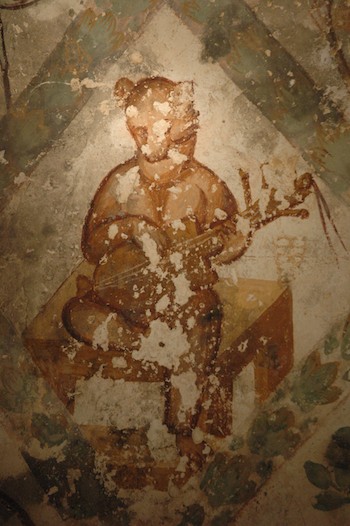
The second stop is the small but gorgeous Amra, which really seems more like a quiet retreat for the caliph than anything else. It's small, just a few rooms, but with an extensive bathing complex. The rooms are decorated with fabulous frescos depicting a host of rather well-endowed women, fruits, animals, and scenes of the caliph's prowess in both hunting and war. The style is similar to some of the Byzantine mosaics and murals we have seen, and it is postulated that the artists may have been trained in the same schools. Interestingly, only a few years after this place was likely completed in the mid-750s, the word went out that portraying human figures was not allowed. Prior to that time, the hadith wasn't entirely clear on that point, and many interpreted the Koran to only forbid portrayals of Allah and Mohammed. Since the caliph presumably didn't want to destroy all the expensive painting work he'd just contracted, Amra was quietly ignored. Fortunately this spot remained out of the way enough to avoid being damaged by the iconoclastic movement, or overly caked in soot by bedouin fires. The paintings are now under restoration, and when they finish it should be an absolute showplace. Even now, dirty and lit only by our flashlights, the place is just incredible. There are no good photos or books about the place; it seems to be unnoticed in this country of amazing things. Let's hope the restoration is completed and the site protected before too many people notice!
Throughout the afternoon the wind has been picking up, and as we are leaving Amra it's become a mini sandstorm. We clamp hats down to our heads and bend over to walk back to the bus, with the dust and sand slowly polishing any exposed skin. Unfortunately, the sandblasting doesn't make me feel cleaner, just grittier. Halfway to the bus, two women stop me by grabbing my arm and insist on taking a photo with me. The older woman, perhaps 50, stands smiling next to me while her daughter takes a picture with her cell phone. I have no idea why she felt quite so firm about getting a picture with the crazy Western woman with the green hat smashed on her head, but apparently she did. Hopefully I'm not now featured in an ad for local beauty products as the "before" example.
We press on into the desert, the wind picking up to the point the bus is weaving a bit on the road, and the signs revealing a worryingly low number of kilometers to the Iraq border. Eventually we reach our destination, the town of Azraq. This former oasis town has been here for hundreds of years, possibly even back to the days of those intrepid desert traders the Nabateans. These days it seems to be mostly a truck stop at the juncture of two highways, and the oasis is long gone, the water piped west to Amman. The fortress here is probably based on an actual defensive structure, built and rebuilt over the years. It is largely fallen into ruin, although the main sight is the couple of rooms just over the gateway that were the office and living quarters of TE Lawrence during the Arab revolt. Lawrence of Arabia is a consistent tourist-grabber, apparently, as is anything involving cam...er...dromedaries. The rooms are not particularly exciting, although when the oasis was still here they must have had a nice view. And probably a good share of mutant desert mosquitos.
The wind and sand have let up slightly at this point, although I can still feel grit in my hair, clothes, and at the back of my throat that no amount of water can dislodge. I am clearly not made for Lawrence-style adventures. We pack up and head west, safely away from Iraq, and back to Amman for the night. Further reflection on water management is worrying; Azraq is Arabic for "blue", named for the beautiful oasis rising from the desert, now just as beige as every other patch of desert for miles around. The Nabateans would be disappointed.
Day 9: Jerash and Amman
This morning we head north to Jerash (Gerasa), another of the Roman decapolis cities on the road between Amman and Syria. Originally we were to follow that same road and wind up in Damascus tonight, but as we know for political reasons this is not possible. The news from Syria the last two days has been terrible. The expected Friday protests were widespread and the response apparently brutal, from what little word is getting out via Al Jazeera. The US and UK are strengthening their travel advisories, and probably a travel warning against all non-essential travel is coming soon. It's incredibly sad, but at the same time I selfishly pine for the opportunity to visit what I hear is a wonderfully welcoming and lovely country. I think Syria might join my personal list of countries with lovely people too nice to overthrow their vicious government (Burma and Zimbabwe being founding members). I hope they find a peaceful solution soon.
Jerash is in the fertile green hills of the east bank of the Jordan river. The hills are terraced, with patches of vegetables (the amazing eggplants we've been devouring all week), olive trees, grapevines, and tomatoes. The population density is much higher than in the rest of the country that we've so far traveled, and it's a bit shocking after being on desert highways. The Roman site is surrounded by the modern city, much like Luxor or Rome itself, with the colonnaded walk about 30 feet from a modern busy road. It's a nice juxtaposition, even if it also means that a lot of the Roman buildings are no doubt buried under someone's field or repurposed into other construction. The site was originally rebuilt by the British in the early 20th century, and my understanding is that although it is a candidate to become a World Heritage Site, this may be made awkward by the freedom taken in restoring some parts of the ruins. Part of the challenge is that the site has remained occupied for thousands of years, so there is the usual jumble of time periods. Among the Roman temples are the remains of Byzantine churches, a synagogue, a cathedral, several caliphate forts, a mosque, and probably a KFC. The darn things seem to be everywhere else.
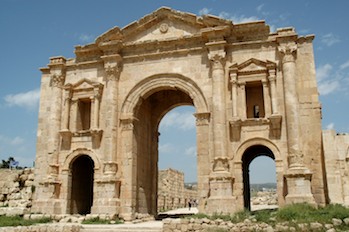
The first thing you come to on entering the site (well, after the guys hawking drinks and stylish hats) is Hadrian's gate. This was built to welcome Hadrian to the city on his visit, although apparently it was a bit ambitious as the gate is a few hundred yards from what was the actual edge of the city at that time. But still, always good to impress the emperor when he comes to town. The gate is a rather nibbled around the edges, partially due to being incorporated into a defensive structure at some point in its history. Next is the hippodrome, unique for having the original start gates and essentially all other components intact. This is now the site of several daily performances by the Roman Army and Chariot Experience (RACE), a group of Army veterans who dress up in gladiator outfits and do a little marching, a little sword fighting, and a nice chariot race around the circuit. It's a bit on the cheesy side, but at the same time it's clearly done with care and does satisfy that Ben-Hur itch. We opt not to commit to the performance, as it would take almost an hour from our time to explore the site, but we do wind up catching a small part of the chariot race while we're climbing on nearby temples so we don't completely miss out. The hippodrome may also be familiar to Top Gear enthusiasts from their recent Middle East special. Steve and I excitedly figure out how they got the cars in and plan to watch the special soon in celebration.
Further on from the hippodrome is a rather unexciting low building that now houses an on-site museum, a visitor center, and a slight hill. Pressing on past all this provides an amazing reward -- the first site of the cardo. Damn the authenticity of the restoration, this is unreal. There is a large, wide colonnaded walk leading to a huge oval plaza, from which the wide cardo (main street) can be seen stretching into the distance. It's just amazing to see all the columns in place, each carefully sized to compensate for the slightly hilly ground so that the viewing experience is one of absolute perfection. The stone of the columns is slightly wider in the middle than at the ends, again to provide the harmonious visual appearance of absolutely perfect parallelism. At this point, I am pretty much lost into a columnar photographic orgy. I proceed to take over 300 photos in the next 90 minutes, almost all of them of columns. The sky is perfectly blue, the light is gorgeous, and it's not so hot that I have to restrict my climbing on things to get the perfect angle. Steve's job at this point is basically to make sure I don't fall off anything and that I drink some water occasionally. He is sadly barred from touching the actual camera. There are limits to my generosity, even after 20 some years.
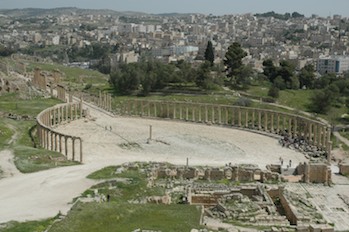
The oval plaza is actually very clever, as the two roads that it joins meet at an angle. The oval is carefully designed in both size and orientation to make that turn seem balanced. In the center, there is a small monument, but honestly it just seems crying out for a big obelisk. Clearly Hadrian should have stopped off for some shopping in Egypt similar to Napoleon. Along the cardo, there are multiple large temples, some of which had been repurposed to churches. The Temple of Artemis is one of the larger structures remaining, and features a lovely symmetric portico. We come to a big intersection (more columns!), although if you turn right you're in the ruins of a cathedral. Apparently the paving stones and column parts were just too tempting, and the Byzatine builders literally built the cathedral around them to create a nice nave. That's ingenuity. Kinda blocks the street, though.
Jerash also features not one but two theatres (I guess one is for the off-cardo independent stuff), one of which is far enough away to emphasize the huge place this must have been. Apparently most of the city wall has also been found, although of course it's now in people's yards and cutting across those nice terraced fields. We climb up a slight rise to look around and I can't help noticing all the suspicious bulges that you can see from here; aerial photography has shown many structures just waiting to be rediscovered. Of course, we can also see the local cell phone store, just to the left of the baths.
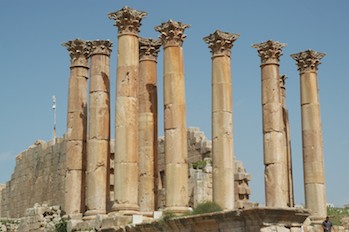
The larger of the two theatres has been restored and is used for concerts. In fact, there is an annual summer festival here starting in the 60s. It's fascinating to see stage lighting and sound equipment scattered around the carefully restored seats. The acoustics are of course amazing, and there's even a conductor stand set up. I tried to convince Steve to try it out, but he just protested and wandered off to stage right. Spoilsport. Next to the theatre is the Temple of Zeus, a large structure interesting in its own right but also featuring amazing views of the plaza and cardo below. I fall into yet another photographic fugue. Columns...columns....
Right! Sorry. Anyway, that's the amazing and astounding city of Gerasa, one of the largest and best-preserved Roman sites outside Italy, and hopefully future World Heritage Site despite the chariot racing.
In the afternoon, we decide to head to the citadel hill of Amman. We'd intended to go when we first arrived, but didn't see all of it, so we wander back to correct our error. Honestly, after all the amazing things we have seen, it's a bit anti-climactic. This large hill in the center of town has one of everything: Roman temple? check. Byzantine church? check. Umayyad fort? check. The guide book notes that there were many other, older structures, but when the Romans arrived they pretty much chucked everything they didn't want to reuse down the hill. (Cue speculative look at the residential district on the hillside.) One of the most interesting things here had been the collection of Dead Sea scrolls kept in the archeological museum, however these have now been moved to a new national museum a mile or so away. It's probably just as well, as the archeological museum is rather old and cramped, and the empty space that presumably held the scrolls doesn't seem nearly well enough climate controlled. We wander through the museum, but honestly there's nothing terribly spectacular on view and a large crowd of French and Italian tourists to press through to get out. That done, we head down to the city via a series of staircases. We probably wouldn't have found the way on our own, but we fortunately saw a young couple walking down together and followed them. I was interested to note that they were holding hands as they walked, which I thought was socially forbidden, but then it's not my neighborhood. She was clearly carrying textbooks and wearing very modern (if modest) clothes, so perhaps there is more freedom in the city.
On our way to the cab, we had our last adventure downtown. We passed a bakery with piles of fresh bread and gorgeous looking cookies. I decided to grab some treats for the long night of packing ahead and dragged Steve in. The constant flow of people in and out stuttered to an awkward halt, clearly perturbed that we had wandered in. I was starting to think this wasn't a great idea when a nice motherly lady in a brown hijab handed me a styrofoam tray and gestured to the cookies. Following her lead, I picked out a handful of delicious-looking treats and went over to the scales. A nice young man pointed out something special I had missed and gestured, so I added one to the pile and was rewarded with an approving smile. Their products are bought by weight, and fortunately the scale had a display in JD. I picked through my coins, looking for correct change, but the nice man behind the counter came over and just plucked out a couple (less than we owed) and then waved me off with a huge smile when I protested. We clearly got the "entertaining tourist" discount. We put our loot in a bag and left, with big smiles and waves all around, following the lady and her daughter. The cookies turned out to be fabulous, by the way, and the special ones had apricot jam filling with pistachio bits.
Our flight leaves the airport at 4:30a, typical for less-traveled nations. The planes come in from Europe in the evening, and then they turn them around and they leave again in the middle of the night, anywhere from 1a-5a. It's the norm, but still rather annoying overall. The drive and the airport are quiet, our flight on a half-full 737, a melancholy end to a wonderful (half) trip. Some places draw you back, and I think this is one; so much has happened in such a very small space, it's hard to really process it all. The natural beauty was more than I expected, and truly a gift to a region where it can sometimes be a struggle to exist. May Jordan remain peaceful and prosperous, and may we return sometime again. For the moment, though, we'll make our way home with our few remaining cookies, a collection of cough drops from various local chemists (Vicks black currant? yes please!) and lots of Alitalia black coffee.